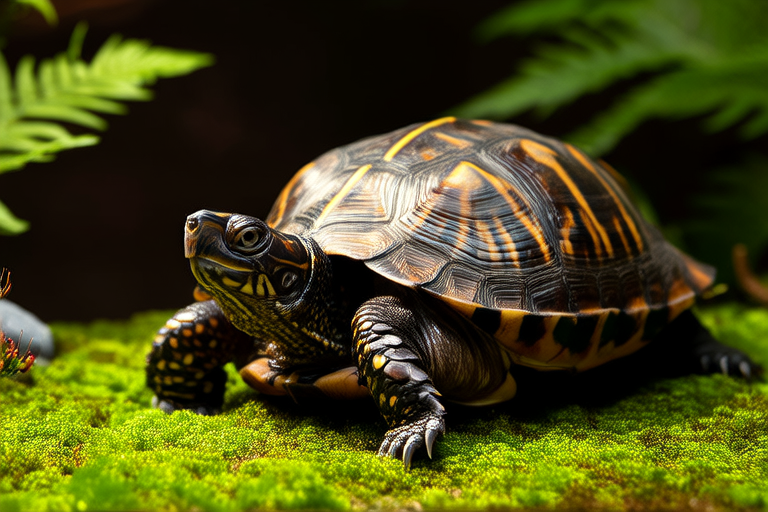Top 7 Secrets of Raising a Healthy Three-Striped Box Turtle at Home
Welcome to the wonderful world of three-striped box turtles! These fascinating creatures make delightful pets, but they require special care to thrive. This guide will help you create the best environment for your turtle, ensuring it remains healthy and happy. We’ll cover everything from habitat setup to diet, temperature and humidity requirements, handling techniques, common health issues, signs of a healthy turtle, and regular care routines.
1. Habitat Setup: Mimicking Natural Environments
The first secret to raising a healthy three-striped box turtle is creating an appropriate habitat that mimics its natural environment as closely as possible. These turtles come from forested areas with plenty of shade and water sources. Therefore, their indoor habitats should reflect this.
Enclosure Size: Provide ample space for your turtle to move around. A general rule is to have at least 10 square feet of floor space for each turtle. This allows them to explore and exercise, which is essential for their physical and mental well-being.
Substrate: Choose a substrate that retains moisture without becoming soggy. Cypress mulch or coconut fiber are excellent choices. Avoid gravel or sand, as these can cause impaction if ingested.
Hiding Spots: Turtles need places to hide and feel secure. Incorporate logs, rocks, and artificial plants to provide hiding spots. This helps reduce stress and encourages natural behaviors.
Water Source: Ensure there’s a shallow dish of clean water for drinking and soaking. The water level should be deep enough for the turtle to submerge itself completely, but not so deep that it poses a drowning risk.
2. Diet: A Balanced and Varied Menu
Feeding your three-striped box turtle a balanced and varied diet is crucial for its health. These omnivorous turtles require a mix of plant matter and animal protein.
Vegetables and Fruits: Offer a variety of vegetables and fruits such as kale, collard greens, carrots, and berries. Ensure these are washed thoroughly and cut into small pieces for easy consumption.
Insects and Protein Sources: Feed insects like crickets, mealworms, and earthworms, as well as occasional pinkie mice. Commercial turtle pellets can also be included but should not form the sole diet.
Calcium and Vitamin D3 Supplementation: Dust food items with calcium and vitamin D3 powder to ensure proper bone development and overall health. However, avoid over-supplementing, as excess vitamins can lead to toxicity.
3. Temperature and Humidity Requirements
Maintaining the correct temperature and humidity levels is vital for your turtle’s health. Proper thermoregulation and hydration contribute significantly to its well-being.
Temperature: Keep the basking area between 85-90°F (29-32°C) and the cooler end around 75-80°F (24-27°C). Use a heat lamp or ceramic heater to achieve these temperatures. Install a thermostat to prevent overheating.
Humidity: Maintain humidity levels between 60-80%. This can be achieved by misting the enclosure daily or using a humidifier. Monitor humidity with a hygrometer to ensure optimal conditions.
4. Handling Techniques: Gentle and Respectful
Handling your three-striped box turtle should be done gently and respectfully to minimize stress. Always support its body, especially the shell, when picking it up. Avoid grabbing the legs or tail, as this can cause injury.
Frequency: Limit handling to necessary occasions, such as feeding or cleaning the enclosure. Excessive handling can stress the turtle and disrupt its routine.
Grooming: Regularly check your turtle’s shell for any abnormalities or debris. Gently brush off dirt using a soft toothbrush. Do not attempt to clean the shell with harsh chemicals or scrub too vigorously.
5. Common Health Issues and Prevention
Despite your best efforts, your three-striped box turtle may encounter health issues. Being aware of these problems and taking preventive measures can help keep your pet healthy.
Respiratory Infections: Symptoms include wheezing, runny nose, and lethargy. Ensure proper ventilation and maintain correct temperature and humidity levels to prevent respiratory infections.
Shell Rot: Characterized by soft, discolored patches on the shell. This condition is often caused by poor hygiene or inadequate substrate. Clean the enclosure regularly and avoid overly moist substrates.
Metabolic Bone Disease: Caused by calcium deficiency. Supplement the diet with calcium and vitamin D3, and ensure access to UVB lighting.
6. Signs of a Healthy Turtle
Observing your turtle’s behavior and appearance can help you determine its overall health. Healthy three-striped box turtles exhibit certain characteristics.
Activity Levels: They should be active and alert, moving around their enclosure and exploring their surroundings.
Appetite: A healthy appetite is a good sign. Your turtle should eagerly consume its meals without hesitation.
Eyes and Shell: Clear eyes and a smooth, hard shell indicate good health. Any discharge, swelling, or soft spots warrant immediate attention.
7. Regular Care Routines
Maintaining a regular care routine is essential for your turtle’s long-term health. Here are some key practices to incorporate into your routine.
Cleaning: Clean the enclosure weekly, removing waste and replacing soiled substrate. Disinfect dishes and accessories with a reptile-safe cleaner.
Lighting: Replace UVB bulbs every six months, even if they still appear functional. This ensures your turtle receives adequate vitamin D3 synthesis.
Monitoring: Regularly check for any changes in behavior, appetite, or physical appearance. Early detection of potential issues can prevent more serious health problems.
Raising a healthy three-striped box turtle requires dedication and attention to detail. By following these seven secrets, you can provide your turtle with the best possible care and enjoy a rewarding companionship. Remember, mimicking its natural environment as closely as possible is key to its well-being. With proper care, your turtle can live a long and fulfilling life.
